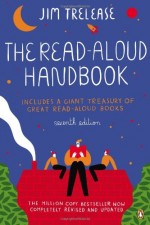
If you want your children or grandchildren to be readers, you have a powerful tool to use to influence them in that direction.
When artist and journalist Jim Trelease began turning his career toward education in 1979, he had been reading aloud to his two children each night, as his own father had once read to him. And he had been visiting classrooms as a volunteer, to talk about careers in art and journalism.
He began to notice that not many of the children he met read very much for pleasure, but the ones who did nearly always came from classrooms where the teachers read aloud daily and incorporated silent reading time into the daily routine.
 He began to investigate the connection and discovered plenty of research written up in academic language in educational journals, but nothing for parents.
He began to investigate the connection and discovered plenty of research written up in academic language in educational journals, but nothing for parents.
So he wrote and self-published The Read-Aloud Handbook. Then in 1982, Penguin USA picked up and published the book, and Dear Abby helped make it known to parents everywhere. It’s now in its seventh edition.
“Every time you read to a child, you’re sending a ‘pleasure’ message to the child’s brain.” —Jim Trelease, author of The Read-Aloud Handbook
At Jim’s information-packed website, Trelease-on-Reading.com, you can read excerpts from the current edition of The Read Aloud Handbook, find downloadable parent brochures, and learn hundreds of fascinating facts about the power of reading aloud.
But why am I writing about this subject here?
It’s because I wonder if children who are read to regularly and who learn to enjoy reading are more apt to view the Bible as a readable book as they grow up.
And oh, how I want them to read it!
So here are some tips to help you develop the wonderful habit of reading aloud to a child.
• Try varying your voice or adding sound effects as you read. No need to be shy!
• If you’re reading an illustrated book, take time to talk about the pictures. Invite your
child to tell you what’s happening in a picture, how a character in an illustration is
feeling, or what might happen next.
• Let your child interrupt the story to ask questions.
• Encourage younger children to hold the book and turn the pages as you read.
• Try to relate a story to your child’s real-world experiences, for example, “Do you
remember when our family took a trip?” or “That donkey looks like the one you rode at
the petting zoo.”
• If your child likes to read aloud, take turns. Let him read to you.
• Remember that good books are made to be read more than once.
Happy reading!
